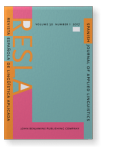Vol. 30:1 (2017) ► pp.52–73
Vol. 30:1 (2017) ► pp.52–73
Comparing advanced L2 and heritage language learners’ Spanish grammars
Some pedagogical considerations
It is very well known that we should take a sociolinguistic teaching approach for Spanish heritage language (HL) learners' instruction. Potowski (2005) proposed that instruction be centered on literacy development and grammatical knowledge. However, not much has been said regarding grammar instruction: What does Spanish HL learners' grammar look like? What are the main similarities and differences between advanced L2 learners and HL learners? What are the most effective grammar teaching techniques for Spanish HL learners? Can those techniques used for L2 grammar teaching be applied to HL learners? In this article, an answer to all of these questions is offered. Moreover, practical examples of activities are provided using several techniques such as processing instruction, interactional feedback, dictogloss, and input enhancement, followed by pedagogical implications derived from current research on grammar instruction for both advanced L2 and HL learners of Spanish.
Article outline
- 1.Introduction
- 2.What do advanced L2 and HL learners’ grammars look like?: Differences and similarities
- 3.Subjunctive acquisition in L2 Spanish learners
- 4.What focus-on-form techniques are effective for advanced L2 Spanish grammar acquisition?
- 5.Which focus-on-form techniques are effective for Spanish heritage grammar acquisition?
- 6.Examples of focus-on-form input techniques for the Spanish heritage classroom
- 6.1Processing instruction
- 6.2Interactional feedback
- 6.3Dictogloss or text reconstruction
- 6.4Input enhancement
- 7.Pedagogical implications of research on L2 and HL Spanish grammar acquisition
- 8.Conclusion
- Note
-
References
This article is currently available as a sample article.
